Microbial Fuel Cells
Bacteria can be used to generate electricity (Let’s Talk Science using image by Gerd Altmann and raphaelsilva via Pixabay)
Bacteria can be used to generate electricity (Let’s Talk Science using image by Gerd Altmann and raphaelsilva via Pixabay)
8.97
How does this align with my curriculum?
Curriculum Alignment
YT
12
Chemistry 12 (British Columbia, June 2018)
Big Idea: Oxidation and reduction are complementary processes that involve the gain or loss of electrons.
ON
11
Environmental Science, Grade 11, University/College (SVN3M)
Strand B: Scientific solutions to Contemporary environmental Challenges
AB
5
Science 5 (2023)
Energy: Understandings of the physical world are deepened by investigating matter and energy.
AB
6
Science 6 (2023)
Energy: Understandings of the physical world are deepened by investigating matter and energy.
BC
10
Science Grade 10 (March 2018)
Big Idea: Energy is conserved and its transformation can affect living things and the environment.
NU
9
Knowledge and Employability Science 9 (Alberta, Revised 2009)
Unit D: Electrical Principles and Technologies
NU
11
Science 24 (Alberta, 2003, Updated 2014)
Unit B: Understanding Common Energy Conversion Systems
YT
10
Science Grade 10 (British Columbia, June 2016)
Big Idea: Energy is conserved and its transformation can affect living things and the environment.
NT
11
Science 24 (Alberta, 2003, Updated 2014)
Unit B: Understanding Common Energy Conversion Systems
AB
9
Knowledge and Employability Science 8, 9 (revised 2009)
Unit D: Electrical Principles and Technologies


